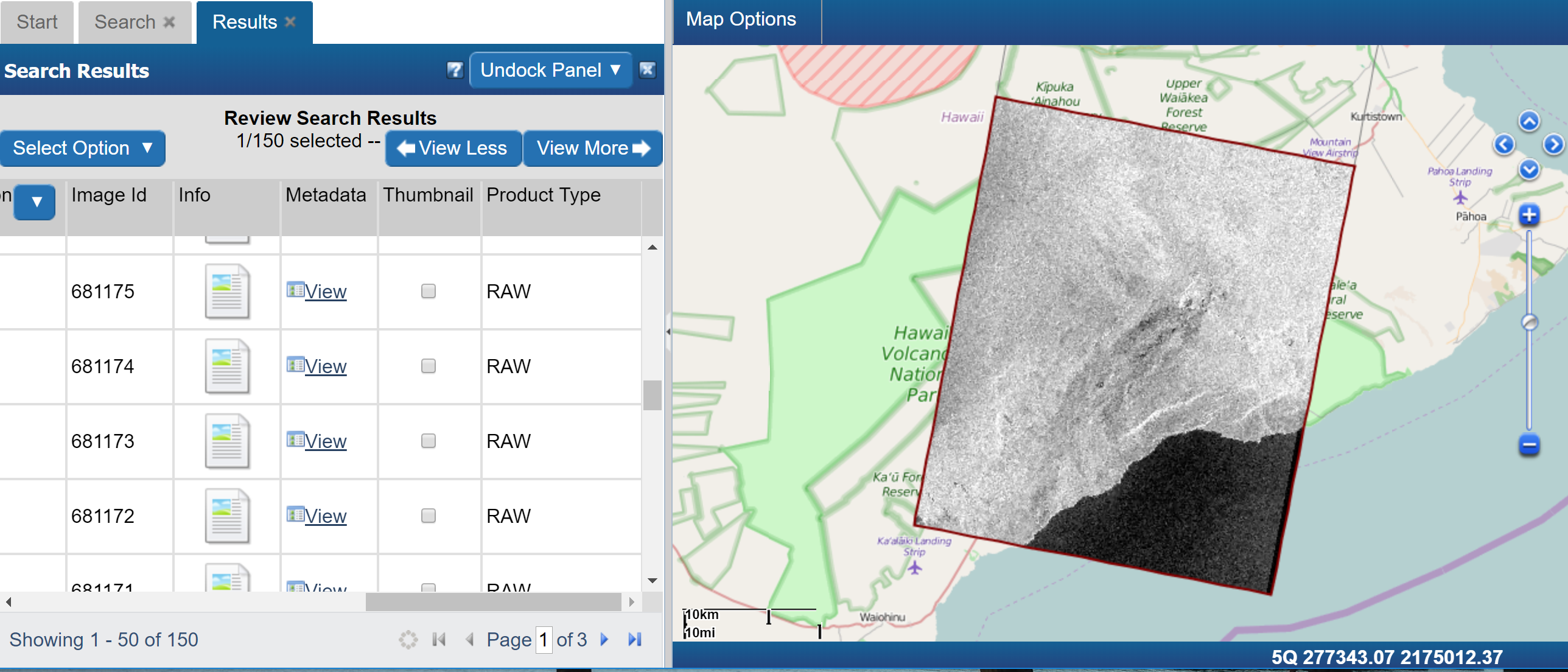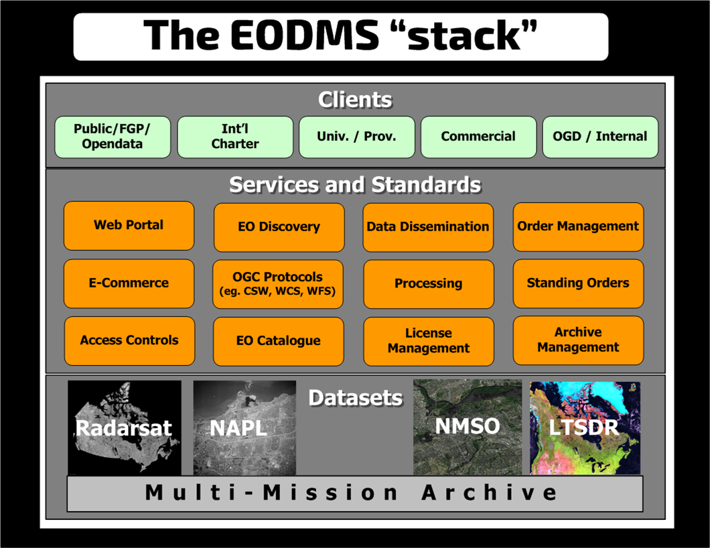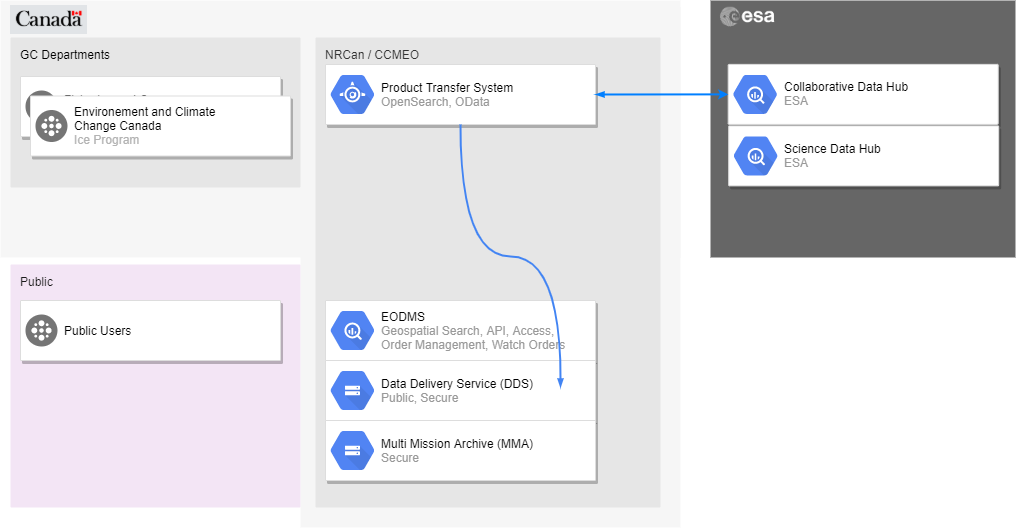Difference between revisions of "Earth Observation Data Management System (EODMS)"
| (9 intermediate revisions by the same user not shown) | |||
| Line 1: | Line 1: | ||
<multilang>@en| | <multilang>@en| | ||
== What is EODMS? == | == What is EODMS? == | ||
| − | The Earth Observation Data Management System (EODMS) is a fully integrated geospatial platform provided by NRCan/RNCan to the general public to discover and access authoritative Earth Observation (EO) data. [https://prezi.com/p/1zp4tsgyn7uz/ _] | + | The Earth Observation Data Management System (EODMS) is a fully integrated geospatial platform provided by NRCan/RNCan to the general public to discover and access authoritative Earth Observation (EO) data. [https://prezi.com/p/1zp4tsgyn7uz/ _]. Check out the [[EODMS How-To Guide]] as well. |
The site is located at https://www.eodms-sgdot.nrcan-rncan.gc.ca/index_en.jsp | The site is located at https://www.eodms-sgdot.nrcan-rncan.gc.ca/index_en.jsp | ||
| Line 29: | Line 29: | ||
* EODMS is also fully OGC compliant having implemented several standards such as Web Map Tile Service (WMTS), Web Coverage Service (WCS), Catalog Services for the Web (CSW) to name a few. EODMS also implements several geospatial ISO standards including ISO 19115 and ISO 19139. | * EODMS is also fully OGC compliant having implemented several standards such as Web Map Tile Service (WMTS), Web Coverage Service (WCS), Catalog Services for the Web (CSW) to name a few. EODMS also implements several geospatial ISO standards including ISO 19115 and ISO 19139. | ||
| − | === | + | === MULTI-MISSION ARCHIVE (MMA) === |
The storage backbone of EODMS is CCMEO’s Multi-Mission Archive (MMA) which is the Canadian authorised repository of over 1PB of RADARSAT-1, RADARSAT-2, RCM, NAPL and NMSO commercial imagery. The capacity of the archive is currently 4 PB and growing. The data is stored robustly using redundant storage and securely to comply with RSSSA laws on access controls and dissemination. | The storage backbone of EODMS is CCMEO’s Multi-Mission Archive (MMA) which is the Canadian authorised repository of over 1PB of RADARSAT-1, RADARSAT-2, RCM, NAPL and NMSO commercial imagery. The capacity of the archive is currently 4 PB and growing. The data is stored robustly using redundant storage and securely to comply with RSSSA laws on access controls and dissemination. | ||
| − | === | + | === COPERNICUS CANADIAN RELAY === |
| − | + | To address the Near-Real-Time (NRT) requirements of its users, CCMEO retrieves data from the [https://colhub.copernicus.eu/ Copernicus Collaborative Hub] and provides a Canadian FTP relay with better download speeds for Canadian end users. | |
| − | + | [[File:Sentinel.draw.io.png|thumb|800x800px]] | |
| − | |||
| − | + | CCMEO provides this service using a small Product Transfer System (PTS) to pull SENTINEL products from the Collaborative hubs via the high speed CANARIE research network through to the EU. It then stages the data on the EODMS Download Server with dependable download speeds. | |
| − | + | While this limited access has operationalized the use of SENTINEL data to key [https://www.gcpedia.gc.ca/wiki/Earth_Observation_Data_Management_System_(EODMS)#COPERNICUS_CCMEO_RELAY GC programs], broad use of SENTINEL-1,2,3,5p is being considered. Please contact us for more info: mailto:nrcan.eodms-sgdot.rncan@canada.ca | |
| − | |||
| − | |||
| − | |||
| − | |||
| − | |||
| − | |||
| − | |||
== Government and Special Access (NMSO, RADARSAT) == | == Government and Special Access (NMSO, RADARSAT) == | ||
| Line 70: | Line 62: | ||
== What's New? == | == What's New? == | ||
| − | The upgrade to EODMS (from NEODF) brings new support for previously undiscover-able NMSO commercial imagery including DMC Constellation, TerraSAR-X, SPOT-4 to 7, Cosmo Skymed. There is also new support for the RADARSAT-2 NITF format. Prior to this users would have to look for this data without the help of a map on the NEODF FTP directory structure | + | The upgrade to EODMS (from NEODF) brings new support for previously undiscover-able NMSO commercial imagery including DMC Constellation, TerraSAR-X, SPOT-4 to 7, Cosmo Skymed. There is also new support for the RADARSAT-2 NITF format. Prior to this users would have to look for this data without the help of a map on the NEODF FTP directory structure. |
| − | |||
| − | |||
| − | |||
@fr| | @fr| | ||
== Qu'est-ce que SGDOT? == | == Qu'est-ce que SGDOT? == | ||
| − | Le Système de données d'observation de la Terre (SGDOT) est une plate-forme géospatiale entièrement intégrée fournie au grand public par RNCan / RNCan pour la découverte et l'accès à des données faisant autorité en observation de la Terre. | + | Le Système de données d'observation de la Terre (SGDOT) est une plate-forme géospatiale entièrement intégrée fournie au grand public par RNCan / RNCan pour la découverte et l'accès à des données faisant autorité en observation de la Terre. Consultez également le [[EODMS How-To Guide]]. |
Le site est situé à l'adresse https://www.eodms-sgdot.nrcan-rncan.gc.ca/index_fr.jsp. | Le site est situé à l'adresse https://www.eodms-sgdot.nrcan-rncan.gc.ca/index_fr.jsp. | ||
| Line 104: | Line 93: | ||
* SGDOT est également entièrement conforme à l'OGC après avoir mis en œuvre plusieurs normes telles que le service de mosaïque de cartes Web (WMTS), le service de couverture Web (WCS), les services de catalogue pour le Web (CSW), pour en nommer quelques-uns. SGDOT met également en œuvre plusieurs normes ISO géospatiales, notamment ISO 19115 et ISO 19139. | * SGDOT est également entièrement conforme à l'OGC après avoir mis en œuvre plusieurs normes telles que le service de mosaïque de cartes Web (WMTS), le service de couverture Web (WCS), les services de catalogue pour le Web (CSW), pour en nommer quelques-uns. SGDOT met également en œuvre plusieurs normes ISO géospatiales, notamment ISO 19115 et ISO 19139. | ||
| − | === | + | === ARCHIVES MULTI-MISSIONS (AMM) === |
L’architecture de stockage d’EODMS est l’archive multi-missions (MMA) du CCMEO, qui est le référentiel autorisé de plus de 1 PB d’images RADARSAT-1, RADARSAT-2, MCR, PNL et NMSO. La capacité de l'archive est actuellement de 4 PB et augmentera de 1 PB chaque année. Les données sont stockées de manière robuste en utilisant un stockage redondant et en toute sécurité pour se conformer aux lois RSSSA sur les contrôles d'accès et la diffusion. | L’architecture de stockage d’EODMS est l’archive multi-missions (MMA) du CCMEO, qui est le référentiel autorisé de plus de 1 PB d’images RADARSAT-1, RADARSAT-2, MCR, PNL et NMSO. La capacité de l'archive est actuellement de 4 PB et augmentera de 1 PB chaque année. Les données sont stockées de manière robuste en utilisant un stockage redondant et en toute sécurité pour se conformer aux lois RSSSA sur les contrôles d'accès et la diffusion. | ||
| + | |||
| + | === RELAIS CANADIEN COPERNICUS === | ||
| + | |||
| + | Pour répondre aux besoins en temps quasi réel (TRN) de certains ministères du gouvernement du Canada (GC), le CCMEO extrait les données de la [https://colhub.copernicus.eu/ Copernicus Collaborative Hub] et fournit un relais FTP canadien offrant une meilleure vitesses de téléchargement pour les utilisateurs finaux canadiens. | ||
| + | |||
| + | [[File:Sentinel.draw.io.png|thumb|800x800px]] | ||
| + | |||
| + | Le CCMEO réalise ce service en utilisant un système de transfert de produit (PTS) léger pour extraire les produits SENTINEL-1 des pôles de collaboration via le réseau de recherche CANARIE auprès de ses homologues (par exemple, GEANT) dans l’UE. Il organise ensuite les données sur le serveur de téléchargement EODMS avec des vitesses de téléchargement fiables pour ses utilisateurs. | ||
| + | |||
| + | Bien que cet accès limité ait rendu opérationnelle l'utilisation des données SENTINEL pour [https://www.gcpedia.gc.ca/wiki/Earth_Observation_Data_Management_System_(EODMS)#COPERNICUS_CCMEO_RELAY les programmes clés du GC], une large utilisation de SENTINEL-1,2,3,5p est à l'étude. Veuillez nous contacter pour plus d'informations: mailto:nrcan.eodms-sgdot.rncan@canada.ca | ||
== Accès spécial (OCPN, RADARSAT) == | == Accès spécial (OCPN, RADARSAT) == | ||
| Line 127: | Line 126: | ||
== Quoi de neuf? == | == Quoi de neuf? == | ||
La mise à niveau vers EODMS (à partir de NEODF) apporte une nouvelle prise en charge des images commerciales des OCPN qui n’ont pu être découvertes sur une carte sans inclure DMC Constellation, TerraSAR-X, SPOT-4 à 7, Cosmo Skymed. Un nouveau support pour le format RADARSAT-2 NITF est également disponible. Avant cela, les utilisateurs devaient rechercher ces données sans l'aide d'une carte sur la structure de répertoires FTP de CNDOT. | La mise à niveau vers EODMS (à partir de NEODF) apporte une nouvelle prise en charge des images commerciales des OCPN qui n’ont pu être découvertes sur une carte sans inclure DMC Constellation, TerraSAR-X, SPOT-4 à 7, Cosmo Skymed. Un nouveau support pour le format RADARSAT-2 NITF est également disponible. Avant cela, les utilisateurs devaient rechercher ces données sans l'aide d'une carte sur la structure de répertoires FTP de CNDOT. | ||
| − | |||
| − | |||
| − | |||
</multilang> | </multilang> | ||
[[Category:Earth Observation]] | [[Category:Earth Observation]] | ||
Revision as of 18:47, 27 November 2019
What is EODMS?[edit | edit source]
The Earth Observation Data Management System (EODMS) is a fully integrated geospatial platform provided by NRCan/RNCan to the general public to discover and access authoritative Earth Observation (EO) data. _. Check out the EODMS How-To Guide as well.
The site is located at https://www.eodms-sgdot.nrcan-rncan.gc.ca/index_en.jsp
History[edit | edit source]
With the second largest landmass on earth and the longest coastline in the world, Canada relies on satellite technology to monitor its land and borders. Providing access to this technology is a core mandate of NRCan's Canada Centre for Mapping and Earth Observation (CCMEO). Through partnerships with government stakeholders, strong links to academia and the private sector, including international collaborations, CCMEO ensures that satellite data is available to serve the needs of the Canadian Government and all Canadians. Since 1971, CCMEO has accumulated an archive in excess of 1 PB of Earth Observation (EO) data. This data originated from various satellites and airborne sensors. The 2012 Canadian Federal Budget included NRCan’s revitalization plan which sought to maintain and improve Canada’s EO satellite capacity and access to this data. This plan was realised through the purchase and installation of four (4) new antennas as well as the brand new Earth Observation Data Management System which replaced several legacy systems.
Services[edit | edit source]
Today, CCMEO delivers several EO data services in support of the Government of Canada’s priorities on the economic development of natural resources, the North, safety, security, sovereignty, and environmental monitoring.
EODMS[edit | edit source]
Data services delivered by EODMS include:
- The user-access-controlled (i.e. Government of Canada only) discovery and ordering of RADARSAT 2 (R2) and RADARSAT Constellation Mission (RCM) product as well as commercial satellite imagery (CSI) procured through the NMSO (i.e. COSMOS-Skymed, Deimos-2, DMC, EROS-B, Flock1-ISS, Flock1-SSO, GeoEye-1, GF-1, GHGSat-D, IKONOS, IRS1C-LISS3, IRS1C-PAN, IRS1C-WiFS, IRS1D-LISS3, IRS1D-PAN, IRS1D-WiFS, IRSP6-AWiFS, IRSP6-LISS3, IRSP6-LISS4, KOMPSAT-2, KOMPSAT-3, KOMPSAT-5, PLEIADES, QuickBird-2, RapidEye, SPOT-4, SPOT-5, SPOT-6, SPOT-7, TanDEM-X, Terra, Terra/Aqua, TerraSAR-X, WorldView-1, WorldView-2, WorldView-3, WorldView-4, ZY-3).
- The generic public discovery of RAW RADARSAT-1, RADARSAT-2 , and RCM Science Data.
- The general public discovery and download of RADARSAT-1 Open Data Products
- The general public discovery and download of Canada Centre for Remote Sensing (CCRS) Thematic Data Sets,
- The general public discovery and ordering of the National Air Photo Library
- EODMS is also fully OGC compliant having implemented several standards such as Web Map Tile Service (WMTS), Web Coverage Service (WCS), Catalog Services for the Web (CSW) to name a few. EODMS also implements several geospatial ISO standards including ISO 19115 and ISO 19139.
MULTI-MISSION ARCHIVE (MMA)[edit | edit source]
The storage backbone of EODMS is CCMEO’s Multi-Mission Archive (MMA) which is the Canadian authorised repository of over 1PB of RADARSAT-1, RADARSAT-2, RCM, NAPL and NMSO commercial imagery. The capacity of the archive is currently 4 PB and growing. The data is stored robustly using redundant storage and securely to comply with RSSSA laws on access controls and dissemination.
COPERNICUS CANADIAN RELAY[edit | edit source]
To address the Near-Real-Time (NRT) requirements of its users, CCMEO retrieves data from the Copernicus Collaborative Hub and provides a Canadian FTP relay with better download speeds for Canadian end users.
CCMEO provides this service using a small Product Transfer System (PTS) to pull SENTINEL products from the Collaborative hubs via the high speed CANARIE research network through to the EU. It then stages the data on the EODMS Download Server with dependable download speeds.
While this limited access has operationalized the use of SENTINEL data to key GC programs, broad use of SENTINEL-1,2,3,5p is being considered. Please contact us for more info: mailto:nrcan.eodms-sgdot.rncan@canada.ca
Government and Special Access (NMSO, RADARSAT)[edit | edit source]
NMSO-CSI[edit | edit source]
The NMSO-CSI is the Government of Canada's initiative to cut down on the procurement of duplicate commercial satellite imagery across the public service. All departments with commercial satellite imagery needs should aim to route all procurement through NMSO E60SQ-120001 after which imagery will be loaded on to EODMS to be re-used (i.e. discovered and downloaded) by the whole of government.
All Government of Canada (GC) employees can have free access to NMSO Commercial Satellite Imagery (CSI) already purchased by the GC. Simply create an account EODMS and then send a request to your Department NMSO point of contact (PoC) for your added privileges. You can find more information on our EODMS_NMSO page as well as the request form and your PoC on our GCPedia (Government-only) page, EODMS Account Approvals for Government and Special Access
RADARSAT[edit | edit source]
Did you know that all Government of Canada (GC) employees have access to RADARSAT-2 and RCM products for free? Simply create an EODMS account and contact the Canadian Space Agency Order Desk for more information (ASC.r-sat.CSA@Canada.ca). (Learn more about RADARSAT)
CSA Special Access Programs[edit | edit source]
Did you know that CSA coordinates several [RADARSAT special access programs] to encourage the use of space data including the The International Charter: Space and Major Disasters. Find out more here.
EODMS accounts are granted to, and must only be used by the specified user; accounts are assigned to individuals (authorized users), and not to Departments or groups of people. Both accounts and passwords remain the property of the Government of Canada, and cannot be transferred to other individuals. All accounts are subject to the policies and regulations of the Government of Canada (e.g., the Treasury Board Policy on the Use of Electronic Networks and the NRCan Policy on the Use of Electronic Networks)
What's New?[edit | edit source]
The upgrade to EODMS (from NEODF) brings new support for previously undiscover-able NMSO commercial imagery including DMC Constellation, TerraSAR-X, SPOT-4 to 7, Cosmo Skymed. There is also new support for the RADARSAT-2 NITF format. Prior to this users would have to look for this data without the help of a map on the NEODF FTP directory structure.



